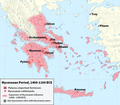The corpus of texts written in the Hittite language is indexed by the Catalogue des Textes Hittites (CTH, since 1971). The catalogue is only a classification... 4 KB (375 words) - 19:06, 29 December 2022 |
language Hittite grammar Hittite phonology Hittite cuneiform Hittite inscriptions Hittite laws Hittite religion Hittite music Hittite art Hittite cuisine... 806 bytes (121 words) - 17:31, 7 July 2022 |
 | Anatolian languages (section Hittite) Luwian survived until the conquest of the Neo-Hittite kingdoms by Assyria, and alphabetic inscriptions in Anatolian languages are fragmentarily attested... 43 KB (4,764 words) - 00:29, 16 April 2024 |
 | Hittite mythology and Hittite religion were the religious beliefs and practices of the Hittites, who created an empire centered in what is now Turkey... 28 KB (3,637 words) - 21:20, 16 November 2023 |
 | Hattusa (redirect from Hittite capital) also Hattuşa, Ḫattuša, Hattusas, or Hattusha, was the capital of the Hittite Empire in the late Bronze Age during two distinct periods. Its ruins lie... 26 KB (3,302 words) - 13:27, 12 March 2024 |
 | Cuneiform (redirect from Cuneiform Inscriptions) used the short trilingual inscriptions from Persepolis and the inscriptions from Ganjnāme for their work. Niebuhr inscription 1, with the suggested words... 348 KB (10,227 words) - 13:03, 9 May 2024 |
 | BC; Lepontic inscriptions date as early as the 6th century BC; Celtiberian from the 2nd century BC; Primitive Irish Ogham inscriptions from the 4th or... 111 KB (10,129 words) - 20:55, 12 May 2024 |
 | Carchemish (category Articles containing Hittite-language text) Neo-Hittite periods, including defensive structures, temples, palaces, and numerous basalt statues and reliefs with Luwian hieroglyphic inscriptions. Between... 42 KB (4,843 words) - 14:58, 8 May 2024 |
 | Kültepe (category Hittite cities) and Hittite sources. In cuneiform inscriptions from the 20th and the 19th century BC, the city was mentioned as Kaneš (Kanesh); in later Hittite inscriptions... 23 KB (2,454 words) - 20:59, 25 April 2024 |
 | with funerary inscriptions recorded for as late as the 5th century AD. The better known laws of the Anatolian peoples were the Hittite laws that were... 11 KB (1,040 words) - 07:29, 27 November 2023 |
 | Anatolian hieroglyphs (redirect from Hittite hieroglyphs) texts are found as monumental inscriptions in stone, though a few documents have survived on lead strips. The first inscriptions confirmed as Luwian date to... 61 KB (1,627 words) - 07:07, 16 April 2024 |
 | Ramesses II (redirect from Egyptian-Hittite wars) Anderson (1996). Ramesside Inscriptions Translated and Annotated: Translations. Volume 2: Ramesses II; Royal Inscriptions. Oxford: Blackwell Publishers... 70 KB (8,302 words) - 02:24, 30 April 2024 |
 | Battle of Kadesh (category Battles involving the Hittite Empire) century BC between the Egyptian Empire led by pharaoh Ramesses II and the Hittite Empire led by king Muwatalli II. Their armies engaged each other at the... 37 KB (4,249 words) - 01:15, 8 May 2024 |
functions in trigonometry "Catalogue des Textes Hittites", the main publication and index of the Hittite inscriptions. This disambiguation page lists articles... 1 KB (211 words) - 13:13, 25 March 2024 |
 | Karatepe (category Hittite sites in Turkey) Karatepe (Turkish, 'Black Hill'; Hittite: Azatiwataya) is a late Hittite fortress and open-air museum in Osmaniye Province in southern Turkey lying at... 8 KB (873 words) - 18:23, 21 November 2023 |
 | Proto-Norse language (section Runic inscriptions) of Proto-Norse are all runic inscriptions in the Elder Futhark. There are about 260 surviving Elder Futhark inscriptions in Proto-Norse, the earliest... 22 KB (2,296 words) - 17:27, 17 April 2024 |







